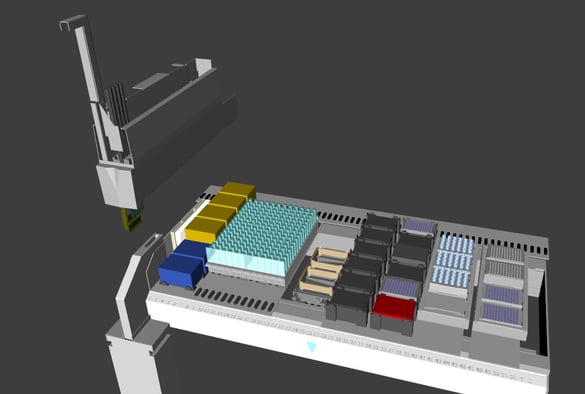Keywords:
By Christian Scherling
The evolution of metabolomics from research to applied science has not been as rapid or dynamic as genomics or proteomics. However, the promise of metabolomics as a diagnostic strategy is becoming much clearer. Metabolomics is evolving into an increasingly common clinical technique across disease types for biomarker screening, diagnostic applications, and determination of treatment efficacy, in clinical toxicology to detect and quantify unknown compounds, and in cancer for tumor profiling.
The use of metabolomic assays in many different aspects of clinical medicine is most certainly on the rise. Driving this phenomenon are mainly the growing number of disease-related biomarkers available and the valuable information they offer clinicians and, importantly, the availability of much more user-friendly, automated mass spectrometry (MS) instruments.
Manufacturers of MS systems recognized the need for researchers and technicians with little to no experience or training in MS to be able to perform MS-based analyses of complex mixtures to identify and quantify metabolites. The high sensitivity of MS – typically Time of Flight (ToF), quadrupole ToF, quadrupole, or orbitrap MS – often combined with a prior separation step such as liquid or gas chromatography, makes it the preferred technique for metabolomics studies, enabling the detection of even low-abundance metabolites.
Preparing samples for MS is not an easy task
Metabolomics differs from other types of omics, such as proteomics or lipidomics to analyze proteins and lipids, respectively, in that the aim is comprehensive profiling of the metabolites of a cell or defined biological system. Metabolomic discovery research compares the presence or absence and different levels of metabolites representing a broad spectrum of biochemical pathways between normal and diseased cell and tissue samples. The resulting biomarkers identified and validated may then be useful in metabolic screening to predict disease risk in target populations, aid in early disease detection, and provide information to guide patient management, for example.
In the clinical setting, accuracy and precision are imperative for metabolic assays. For the analysis of individual patient samples, the expectation is for rapid turnaround and results today rather than tomorrow. In drug screening or biomarker identification studies, such as might be part of a clinical trial protocol, speed and high-throughput MS-based assay workflows are essential, with extremely precise processing of large numbers of samples needed to ensure consistency, avoid cross-contamination, and achieve accurate, high quality results.
As described, at the analytical heart of the metabolomic workflow is MS, which typically requires extensive sample preparation. In exactly the same way that robotic liquid handling systems and automation of sample preparation in recent years have had a substantial impact on the standardization and improvement of sample processing for genomic and proteomic analyses, clinical laboratories and core MS facilities are experimenting with novel, cost-effective approaches to automate the preparation of blood, urine, and other samples prior to MS analysis.
Clinical metabolomics in the real world
Kennedy et al. demonstrated the use of metabolomics profiling of human urine to screen for multiple different types if inborn errors of metabolism (IEMs).1 They identified more than 1,200 biochemicals (ranging from 50-1500 Da molecular weight) in 100 clinical urine samples and presented clear biochemical signatures for 16 of 18 IEM diseases tested (with the two diseases not resulting in signatures occurring in patients receiving treatment that masked the biomarkers detected by the assays used).
“Metabolomics can be utilized as a broad-based screening tool in association with other standard diagnostic tools to confirm diagnoses,” stated the researchers. “Multiple assays and sample types can potentially be ‘collapsed’ into a single sample and the single metabolomics ‘assay’ as a first pass point for clinicians to reflex test using these standard diagnostic assays.”
An additional advantage of being able to perform metabolomic screening using urine, in this case, is that, “The sensitivity and breadth of the metabolomics method…may also circumvent the need to obtain invasive sample types such as cerebrospinal fluid,” concluded the authors.
Promise of metabolomic biomarkers in cancer
“Altered metabolism has recently been acknowledged as a key hallmark of cancer,” state Vermeersch and Styczynski, noting in particular that cancer cells utilize a different form of energy metabolism than normal cells, primarily relying on anaerobic glycolysis instead of oxidative phosphorylation.2
“Metabolites are theoretically ideal biomarkers and diagnostics because they can be easily measured from non-invasive urine or blood samples,” add the authors. Research has shown promising results for detecting metastatic disease using metabolic profiling of these bodily fluids. The researchers also describe the “emerging field of pharmacometabolomics, to predict drug efficacy and toxicity.”
However, they conclude, “some issues must still be better addressed before metabolomics has more broad and direct clinical impact. For example, sample acquisition and preparation must be rigorously standardized in order to produce results that are reproducible enough for clinical applications, since large and fast intracellular changes in metabolite concentrations are possible during biopsies.”
Why recreate the wheel?
Today, it’s fully feasible to automate metabolomics sample preparation and analysis for clinical scenarios, including matrix cleanup by solid phase extraction (SPE), precipitation and phase separation of polar and nonpolar compounds, and sample tracking.
As an industry-leading manufacturer of robotic liquid handling systems and flexible, automated platforms that provide sample preparation solutions for a broad range of applications, Tecan can work with you to create an accurate, robust, and reliable approach that fully automates your sample preparation process. You will benefit from the ability to process large numbers of samples quickly, with high precision and a high degree of standardization from run to run. By working with an experienced, global leader, you can expect an easy and smooth transfer of your in-house method – or automation of commercial kits – to a ready-to-use robotic platform that meets your needs today and has the flexibility to grow with your laboratory into the future.
References
- Kennedy AD, Miller MJ, Beebe K, et al. Metabolomic profiling of human urine as a screen for multiple inborn errors of metabolism. Genetic Testing and Molecular Biomarkers 2016;20(9):485-495.
- Vermeersch KA, Styczynski MP. Applications of metabolomics in cancer research. J Carcinog 2013;doi:10.4103/1477-3163.113622.
Keywords:
About the author

Christian Scherling
Christian Scherling holds a PhD involving metabolomic and proteomic studies, and postdoc positions in core facilities in metabolomics and systems biology. He has extensive experience in automated workflows, consulting with labs around Europe. At Tecan he focuses on automated sample preparation for mass spectrometry applications for Pharma, Clinical Diagnostics, Omics (Metabolomics, Proteomics, Lipidomics), Forensics & Toxicology.











